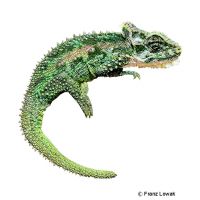Natal Midlands Dwarf Chameleon (Bradypodion thamnobates)
| Natal Midlands Dwarf Chameleon Bradypodion thamnobates | |
|---|---|
| Name | Natal Midlands Dwarf Chameleon |
| Name Lat. | Bradypodion thamnobates |
| Family | Chameleons |
| Family lat. | Chamaeleonidae |
| Order | Scaled Reptiles |
| Order lat. | Squamata |
| Origin | South Africa |
| Habitat | Shrub and deciduous forests |
| Diet | Insects |
| Humidity | 60-80 % |
| Behavior | Semi-aggressive |
| Keeping | Individual, pair |
| Care Level | Experts only |
| Reproduction | Ovoviviparous |
| Housing | Semi-humid terrarium |
| Life Span | 3-4 years |
| Protection | CITES Appendix II; EU Annex B |
| Metric Units | |
| Size | 18 cm |
| Temperature | 26-28 °C |
| Temperature Local | 30-35 °C |
| Housing Size | 80 x 60 x 100 cm |
| US Units | |
| Size | 7" |
| Temperature | 79-82 °F |
| Temperature Local | 86-95 °F |
| Housing Size | 30" x 25" x 40" |
Distribution and habitat
The diurnal Natal Dwarf Chameleons occur in a very small area in Natal Province (South Africa), from Bulwer to Dargle and along the Mooi River. There they live in the bushes, shrubs and trees.
Maintenance
Minimum dimensions for the terrarium, according to the size and number of animals:
| One animal | 4KRL x 2,5KRL x 4KRL (L x W x H) |
Head-torso length (KRL) is measured on the largest animal. For pair keeping, increase the floor space by 20%. A terrarium of e.g. L 80 x W 60 x H 100 cm is recommended, which should be placed in a quiet and vibration-free place.
You need a well ventilated terrarium structured with branched climbing branches as well as robust (also artificial) plants as a screen, structured back and side walls (e.g. cork covering), a substrate of sand-peat mixture and a small water container or better a drip trough. A larger part of the substrate should always be kept slightly moist. Once a day, preferably in the evening, the inside of the terrarium should be finely sprayed with water (humidity), but it is better to use a rain or mist system.
| Temp. day: 26-28 °C | Temp. night: 14-18 °C | Temp. local: up to 35 °C | Humidity: 60-80 |
The lighting duration must be 10-14 hrs. depending on the season. They need a high light intensity. Special lamps with high UV-A and UV-B content are ideal.
Diet
The food supply consists of live insects, such as crickets, grasshoppers and crickets. Sometimes the switch to commercial ready-made food for insectivorous reptiles, which must be offered with tweezers, is successful. Wax moths should be fed infrequently and in very small amounts because of their large fat content. Regular addition of minerals and vitamins (dusting the food) is important. Since water is almost only absorbed in drop form from leaves or furnishings, a dropper is recommended, alternatively they can be watered daily from a pipette
A regular and varied diet promotes health and prevents deficiency symptoms.
Reproduction and breeding
The male has a thicker tail root with a clearly visible hemipenis pouch.
The female incubates her eggs (up to 26 eggs) in the abdominal cavity (ovoviviparous). After 3-6 months of gestation, she randomly pins the young, which are surrounded by a sticky covering, into the branches; they then hatch immediately from their egg membrane. Small insects such as fruit flies are suitable as initial food.
The life expectancy can be 3-4 years.
Species protection
The animal population must be reported to the competent authority in writing immediately after the start of keeping. Your pet store will be happy to provide you with further information.
Protection of species: WA Appendix II; EU Appendix B. The proof of purchase is the required proof of origin for the animal. Please keep it safe!
Important
They are very active and need a correspondingly large terrarium.
Outdoor keeping in summer, in a species-appropriate aviary, is beneficial for the well-being of the animals due to the temperatures prevailing in Central Europe. For the resting phase, the lighting duration is reduced by 2-3 hours for about two months and the daytime temperature is lowered by 6-10 °C as well as the air humidity is reduced
With fruit and honey water as food for the feeding animals, their quality can be upgraded.
The terrarium must have good ventilation without drafts and meet the species specific needs. Measuring devices such as thermometers, hygrometers, etc. are necessary. The lighting has to correspond to the species-specific day-night rhythm and has to be placed in such a way that the animals cannot injure themselves. The terrarium should be locked in such a way that neither unauthorized persons can open it nor the animals can escape. Contamination must be removed regularly
Further literature can be found in your pet store.
References
Text: Christian Sänger; Image: Franz Lowak
Source: BMELV (1997): Mindestanforderungen an die Haltung von Reptilien; ENGELMANN (2006): Zootierhaltung - Tiere in menschlicher Obhut: Reptilien und Amphibien, Harri Deutsch Verlag
- Gemäß § 21 Abs. 5 Tierschutzgesetz idgF
